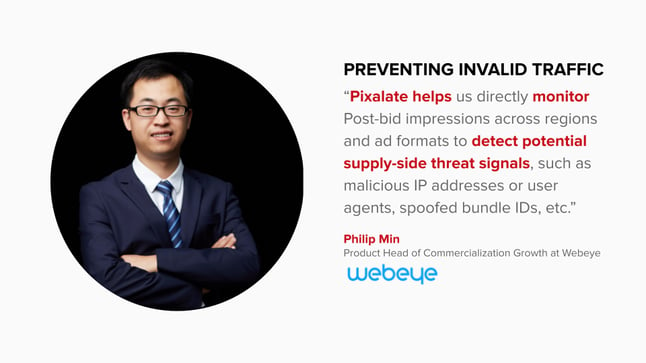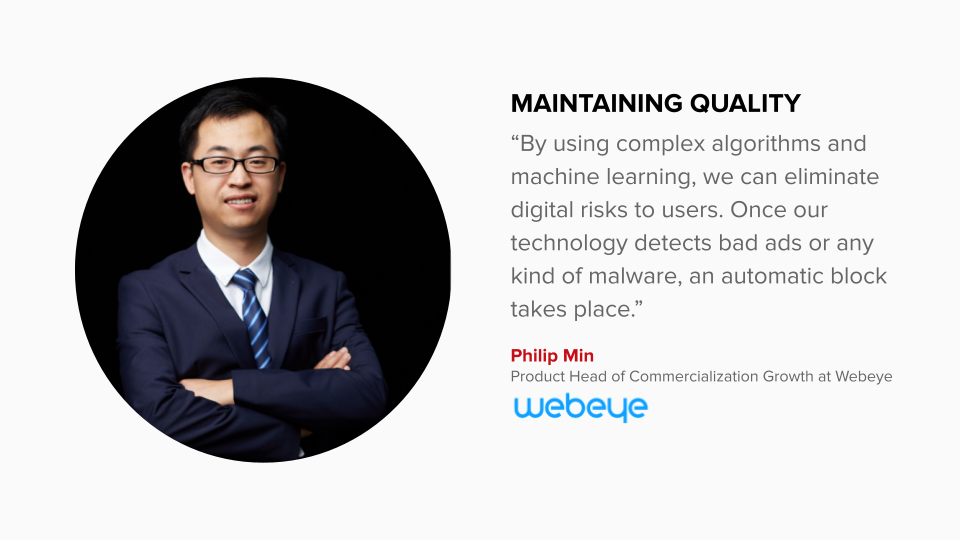

Pixalate spoke with Philip Min, Product Head of Commercialization Growth at Webeye, about the best practices in maintaining quality in the open programmatic marketplace.
What services does Webeye offer?
Driven by innovation, powered by technology, Webeye helps all enterprises achieve global development.
How does Webeye protect its customers from invalid traffic (IVT) and ad fraud?
At Webeye, our top priority is to offer a clean, protected marketplace. We combine human expertise and sophisticated automated systems to create a safe and secure platform for publishers and marketers alike. To create a safe environment for our clients, Webeye deploys the latest technology to fight against ad fraud and IVT. Our automated detection methods use advanced algorithms and machine learning to scan traffic for quality. We are using Pixalate to do fraud detection. We integrated with Pixalate’s Pre-bid data feed to automatically scan every ad call to our exchange and block GIVT and SIVT in accordance with Media Ratings Council-established best practices. Moreover, Pixalate helps us directly monitor Post-bid impressions across regions and ad formats to detect potential supply-side threat signals, such as malicious IP addresses or user agents, spoofed bundle IDs, etc.
How do you maintain a quality and privacy-friendly ad ecosystem on your mobile programmatic advertising platform TaurusX?
At Webeye, we care about helping drive revenue while protecting users from harmful ad experiences. We developed a robust, proprietary system that scans creatives served across the TaurusX marketplace in all regions. By using complex algorithms and machine learning, we can eliminate digital risks to users. Once our technology detects bad ads or any kind of malware, an automatic block takes place. This helps to keep our marketplace clean, healthy, and trustworthy.
We also have extensive ad tech experience and leverage the latest industry developments. Technology is just one piece of the puzzle, as our dedicated Ad Quality team takes a hands-on approach to eliminate any quality issues. With extensive historical data, our experts can discover harmful ads that may not have been automatically blocked. Much like the machine learning used by our automated systems, our Ad Quality team continually adapts to address evolving ad threats.
Meanwhile, we work with industry-leading partners (e.g., GeoEdge) to ensure that our ad quality standards remain high and threats to users are blocked on the TaurusX marketplace.
 What are the key signals you look for in a good inventory source?
What are the key signals you look for in a good inventory source?
Signals such as inventories that keep low IVT level, app ratings at stores, comments under app, cumulative downloads, whether compliant to policies, the completion of information like language or IP.
What other help do APAC advertisers need to ensure their budgets are safely spent in programmatic advertising?
Sources like Pixalate can provide user quality data from more dimensions to help reduce the proportion of invalid users. We also want to understand IVT's characteristics more deeply through case studies.
What do you think is the most critical factor to successfully start the journey into traffic quality and IVT/Fraud management?
Firstly, it is crucial to cooperate with partners who have been certified and/or accredited by the industry-leading bodies in fraud protection or are using services bearing such certifications and/or accreditations.
Technology certainly plays a critical role in safeguarding inventories and advertising campaigns, but it’s our in-house team of experts that really delivers. The Ad Quality and Traffic Quality teams provide hands-on coverage from around the world to ensure that our partners are always protected, and our platform's ecosystem is safe and sound. Using advanced detection methods and decades of combined experience, our experts are able to quickly eliminate any threats on the Webeye platform.
*By entering your email address and clicking Subscribe, you are agreeing to our Terms of Use and Privacy Policy.
These Stories on Case Studies
*By entering your email address and clicking Subscribe, you are agreeing to our Terms of Use and Privacy Policy.

Disclaimer: The content of this page reflects Pixalate’s opinions with respect to the factors that Pixalate believes can be useful to the digital media industry. Any proprietary data shared is grounded in Pixalate’s proprietary technology and analytics, which Pixalate is continuously evaluating and updating. Any references to outside sources should not be construed as endorsements. Pixalate’s opinions are just that - opinion, not facts or guarantees.
Per the MRC, “'Fraud' is not intended to represent fraud as defined in various laws, statutes and ordinances or as conventionally used in U.S. Court or other legal proceedings, but rather a custom definition strictly for advertising measurement purposes. Also per the MRC, “‘Invalid Traffic’ is defined generally as traffic that does not meet certain ad serving quality or completeness criteria, or otherwise does not represent legitimate ad traffic that should be included in measurement counts. Among the reasons why ad traffic may be deemed invalid is it is a result of non-human traffic (spiders, bots, etc.), or activity designed to produce fraudulent traffic.”

